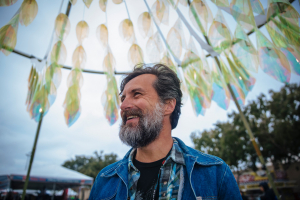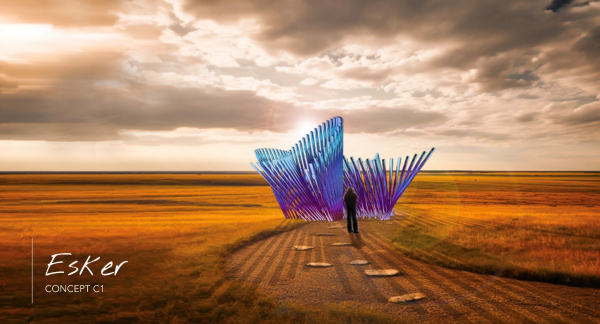![]()
![]() North Dakota has eight distinct regions. Northeastern North Dakota’s Region 4 is comprised of Pembina, Walsh, Grand Forks and Nelson Counties. Regional and local leaders from business, arts, education and community were recruited and met over a year's time to formulate a roadmap for the development of one site to be the artistic, historical, and cultural representation for all four counties.
North Dakota has eight distinct regions. Northeastern North Dakota’s Region 4 is comprised of Pembina, Walsh, Grand Forks and Nelson Counties. Regional and local leaders from business, arts, education and community were recruited and met over a year's time to formulate a roadmap for the development of one site to be the artistic, historical, and cultural representation for all four counties.
Current Status: Artist James Peterson is planning for the installation.
Artist
 Originally from Muskegon, Michigan, James Peterson is a large-scale sculptor and designer who has installed artworks at various locations across the United States for over 15 years. He graduated from Kendall College of Art and Design with a BFA in sculpture, while also exploring design, illustration, and art history. His artistic evolution has featured fluid and dynamic work that includes both organic and mechanical motifs with a focus on immersive interaction. Grounded in mathematics to achieve the form, his sculptures are a representation of how nature grows and develops.
Originally from Muskegon, Michigan, James Peterson is a large-scale sculptor and designer who has installed artworks at various locations across the United States for over 15 years. He graduated from Kendall College of Art and Design with a BFA in sculpture, while also exploring design, illustration, and art history. His artistic evolution has featured fluid and dynamic work that includes both organic and mechanical motifs with a focus on immersive interaction. Grounded in mathematics to achieve the form, his sculptures are a representation of how nature grows and develops.
James has exhibited at the Pacific Design Center, Art Basel Switzerland & Miami, Miami Biennale, Grand Rapids Art Museum, Kunst Raum Switzerland, Coachella Art & Music Festival, Meow Wolf Vegas, Burning Man, Maker Faire, and more.
In addition to his purely artistic pursuits, James has been featured in a contraption-based television show and a myriad of feature films. He now operates his own design and fabrication house, Art & Contraptions after working in Hollywood’s visual effects industry and teaching digital fabrication at SCI-ARC (Southern California School of Architecture).
Currently, James resides in Los Angeles with his wife and son. To see images of his past works, visit his website: www.ArtContraptions.com
Proposed Design

James Peterson presented numerous design concepts to the Selection Committee. Two of Peterson's concepts, ‘SKY’ and ‘ESKER’, "are tall aluminum pipes arranged in layers that create multiple winding pathways to move through while compelling viewers to gaze up towards the endless sky. The pipes are color-coated providing another layer of visual depth and complexity as the light is reflected on them." Working with the artist to select the final design, the committee was drawn to how his proposals referenced the vast North Dakota sky and the eskers that snake through the region. An esker is a glacial deposit, or a long narrow ridge of sand, gravel, and boulders deposited by a stream that melted away, leaving a complete reversal of the topography.
In his final application, Peterson wrote, "I cannot overstate how delighted I am to have this vast rural landscape as a venue for one of my artworks. I see these concepts as robust artworks that celebrate the power and beauty of North Dakota’s landscape. Inspired by the very forces that shaped our world, these artworks invite you to experience the wonder of our natural world in a way that is truly unforgettable."
*Final design to be determined.
Cultural Heritage
Region 4 Stakeholders met over 12 months and discussed the area’s culture and history. Interesting concepts emerged: water, resilience, the movement of Native people and immigrant settlers, transformation and the landscape of steep hills and valleys, open prairie with endless sky and stars.
The Esker represents "the forces of nature that have impacted not only our landscape but our lives". It ties into adjectives that describe our human history and the human traits that have helped us survive and thrive. The height and perspective of looking out over the land was an important aspect discussed. The location represents the endless sky and dynamic layers of the region - indigenous culture, roaming buffalo, our glacier landscape of steep hills and valleys, open prairie with endless sky and stars.
Eskers are, in effect, inverted river channels that snake their way across the countryside. Eskers were deposited by streams and rivers flowing on the surface of a glacier, in cracks in the glacial ice, or, sometimes, in tunnels beneath the ice. These Ice-Age rivers and streams deposited gravel and sand in ice-walled valleys, just as a modern stream deposits sediment in its earthen valley. When the ice banks of the esker rivers eventually melted away, the gravel deposits in the ice-walled valleys remained as ridges above the surrounding countryside.
North Dakota has thousands of esker ridges. Most are small and non-descript, apparent only from ariel views, but some eskers are impressive. The Dahlen Esker is one of the best examples of an esker in the U.S., located midway between Fordville and Dahlen. It can be seen as a prominent ridge off to the west where State Highway 32 crosses the Grand Forks-Walsh County line. Dahlen Esker was deposited by a meltwater stream flowing in an ice-walled channel, most likely a tunnel, near the edge of the glacier. This esker is about four miles long, 400 feet wide, and as high as 50 to 80 feet. In some places, native prairie covers the surface. It is surrounded by farmland.
Installation Site
The artwork will be located on private land near the Dahlen Esker, midway between the city of Fordville, in Walsh County, and Dahlen, a small unincorporated community in Nelson County.
Stakeholders
NDCA Board Member, Lead Contact
- Dawn Mandt, Executive Director, Red River Regional Council (Walsh County)
Grand Forks County
- Kathy Armacost, Grand Forks Public Arts Commission Board Member
- Alvin Boucher, Grand Forks Municipal Judge, Muddy Waters Clay Center
- Ann Diepolder Brown, retired physician, former chair of North Dakota Museum of Art, Board member of Public Art Commission
- Becca Cruger, Workforce Development Manager, GFREDC
- Hazel Sletten, Board President of the Larimore Community Museum, retired from City of Grand Forks Water Utilities
Nelson County
- Anna Halvorson, Administrator, Good Samaritan Society
- Sarah Heitkamp, Curator & Director of UND Art Collections; Instructor, Dept. of Art & Design; Honors
- Anna Huso, Photographer
Pembina County
- Patricia Caylay, Member of Fort Pembina Historical Society, Historic Preservation Commission
- Zelda Hartje, Chair, Historic Preservation Commission, Property Tax Assessor
- Barb Gunderson, Photographer
- Lule Naas, Destination Red River Project Manager, Red River Regional Council
- Becky Ratchenski, Retired Library Director & Teacher
- Lillian Stegman, Artist
Walsh County
- Kelsey Beckstrom, Drift Prairie Development, LLC
- Travis Bell, Farmer, Landowner
- Agatha Frisby, Architect, Prairie Centre Architecture
- Emma Narloch, Student, Grafton High School
- Cheryl Osowski, Red River Regional Council
- Crystal Voth, Art Instructor, Grafton High School
- Jacy Whaley, Occupational Therapist
Sponsors
The statewide Arts Across the Prairie: Placemaking in Rural North Dakota program is a collaboration with North Dakota Department of Transportation, North Dakota Commerce and Tourism, and the State Legislature. NDCA is working with the Red River Regional Council in Grafton to facilitate the Region 4 project.
Nearby Attractions
Coming soon
Timeline
Coming soon
